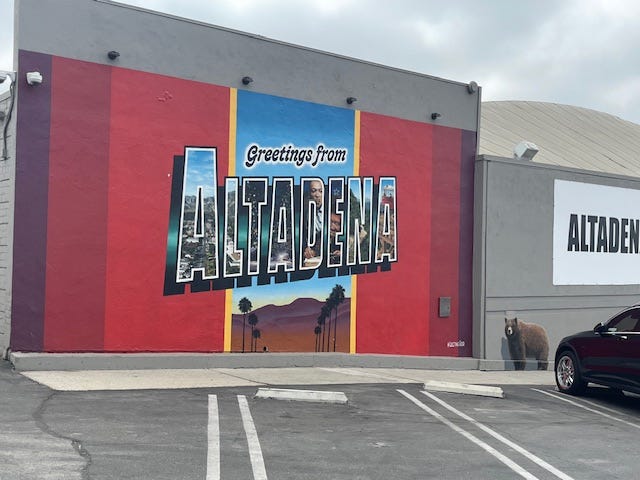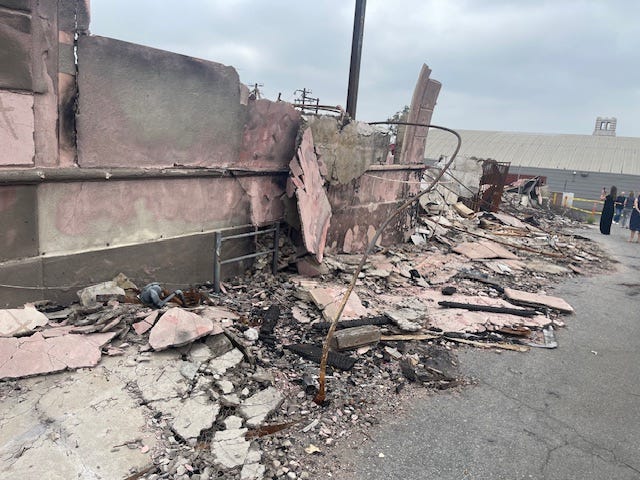Is Anywhere Safe, Part 5: Rebuilding Altadena
The Los Angeles suburb has long been a magnet for middle-class Black homeowners. It will probably be rebuilt in a more attractive way. But will it offer the same opportunities as it has in the past?
The Future Of Where relies on you to help spread the word and expand our audience. If you like this post, which is not behind the paswall, please pass it along to others who might be interested in becoming subscribers!
Last week I toured the wildfire destruction in Altadena for the first time since the devastating Los Angeles wildfires in January. Most of the debris is gone, but the damage is pretty obvious: Blocks and blocks and blocks just empty, because almost 10,000 structures—including 6,000 homes – were destroyed.
Now the hard work of rebuilding begins. And that means some hard choices are ahead.
The very affluent community of Pacific Palisades – adjacent to Malibu – has gotten most of the national publicity since the January fires, because rich people and celebrities live there. But Altadena is, in many ways, a more interesting case study of recovery.
Altadena is an unincorporated community adjacent to affluent and historic Pasadena. Like a lot of unincorporated areas near affluent cities, it’s always been demographically diverse and a place of opportunity for people of color. In particular, parts of Altadena have always been a community of homeownership opportunity for African-Americans. (Research by UCLA shows that African-Americans were disproportionately affected by the fire.)
Like so many parts of L.A., Altadena was no longer cheap – median home price was over $1 million before the fire – but historically it was a mostly single-family, mostly middle-class, and traditionally affordable community. Up against the foothills of the picturesque San Gabriel Mountains, Altadena featured modest homes and a local shopping street along Lake Avenue, stretching north out of Pasadena.
The Challenge of Recovery
The challenge Altadena now faces is twofold: how to help local residents – many of whom were under-insured – rebuild their homes, and whether and how to concentrate new development in specific locations away from hillside areas and near Lake Avenue. Neither is easy, and both are somewhat controversial.
One thing that became clear on our tour, which was part of the Casita Coalition’s “Build The Middle” 2025 National Housing Convening, is that the wildfire has motivated the Los Angeles County Regional Planning Department to take many long-delayed actions to streamline permit approvals. The county set up a separate recovery unit to handle wildfire rebuilding and streamlined so-called “like for like” rebuilds – rebuilding structures that are more or less the same as the structures that burned down.
Similarly, the county is moving forward, in cooperation with nonprofit organizations, with several preapproved building designs that would also see expedited approval.
Not everybody is moving forward with “like for like” or preapproved. For example, one of the speakers – who happened to be an L.A. County planner and a former student of mine – said she made the decision not to rebuild her 1,200-square-foot house like-for-like and instead go through a much more complicated process to build a 1,600-square-foot replacement home.
The irony, of course, is that steps like permit streamlining and preapproved designs have been under discussion in L.A. County – and many other places – for years. But it took a disaster to motivate everybody to put them into place. This is something that we’re going to see more and more of in the years ahead, as we, tragically, see more disasters.
How Will Altadena Be Different?
But the bigger question is not whether everybody will be able to rebuild what they had before. The bigger question is whether Altadena – like the Palisades – can and/or should be rebuild back differently. And that’s a pretty big debate in Altadena and elsewhere in L.A. right now.
Ironically, the L.A. County Board of Supervisors approved the new West San Gabriel Valley Area Plan – which covers Altadena – four weeks before the fire. The plan called for downzoning hillside areas – which were designated as high fire risk – and upzoning areas in the central part of Altadena, much of which also suffered severe wildfire damage. The plan calls for more significant protection of hillside areas, including mitigation measures designed to limit potential wildfire damage, while including the usual policies on walkable and connected communities, mixed use, and commercial areas such as Lake Avenue that will be more dense and lively.
Here's hoping Lake Avenue does become a more walkable commercial center as a result of the recovery. (My former student, the L.A. County planner, said that even as she is devastated that she lost her home, she is looking forward to being able to walk to more destinations on Lake, just a couple of blocks away).
Where the battle is likely to play out, however, is not along Lake Avenue but in the now-devastated residential neighborhoods. Many houses will be built back like-for-like. Many more will be built back, as my former student’s will be, at a larger scale. But, especially as developers and investors gain control of some residential parcels because underinsured residents have to let go of them, there will be strong disagreement about whether to build back differently – and, in particular, more densely – in the residential neighborhoods.
Over the past few years, California has – at least in legal terms – done away with single-family zoning. Accessory dwelling units can be built by-right, and a couple of years ago the legislature passed a bill known as SB 9, which essentially permits a lot split and four units on every single-family parcel by right.
SB 9 has not been widely used – it’s easier to build an ADU – but nevertheless there has been concern on the part of longtime homeowners that developers will scoop up residential lots in wildfire areas and use SB 9 widely to build more intensely in fire-stricken single-family neighborhoods. In response to this, Gov. Gavin Newsom has suspended SB 9 and provided local governments with the ability to do so as well. (It’s a bit ironic that after seven years of asserting state control over housing, he characterized his move as “strengthening local control”.) Mayor Karen Bass on Los Angeles, who controls the Palisades but not Altadena, has done the same. (Last Wednesday, L.A. County followed suit.)
Not surprisingly, California’s YIMBY groups appear to be getting ready to sue to stop SB 9 suspension. That will drag the whole SB 9 question into court for a long time. But based on our tour the other day, it’s pretty clear that many property owners in Altadena will choose to add an ADU to their property, which is pretty easy under both state law and local ordinance.
So what will see in Altadena in the end? Less building in the hillsides, a more walkable commercial district along Lake Avenue, and a great variety of residential situations including more ADUs. So, in physical terms, probably a more pleasant, accommodating, and diverse community.
Of course, whether that community will provide the same opportunities to middle-class families as it has in the past remains to be seen. The experience of other wildfire-riddle communities – such as Paradise in Northern California, which burned down in 2018 – is that the longtime households of modest means leave, prices go up, and more affluent folks move in. That’s probably what will happen in Altadena, especially if the changes made after the wildfire make it, ironically, a more attractive place to live.




